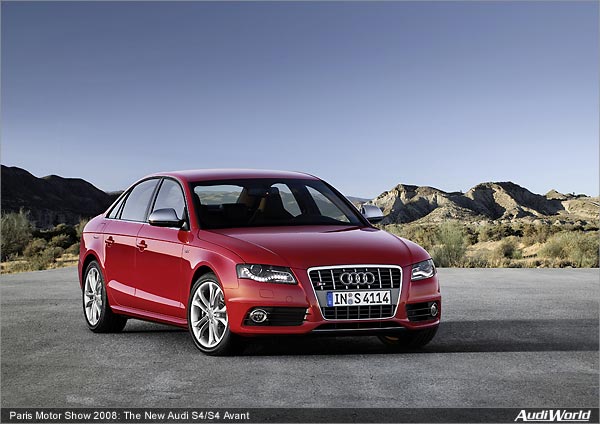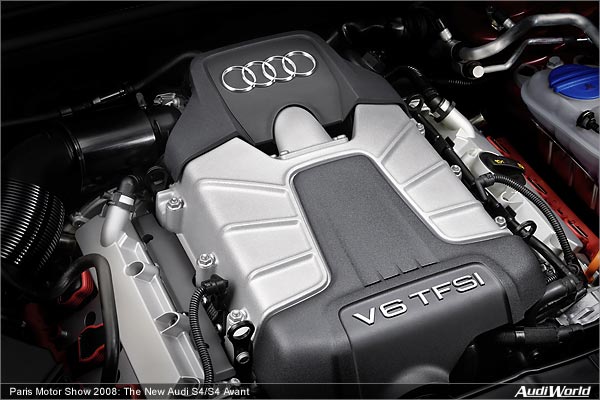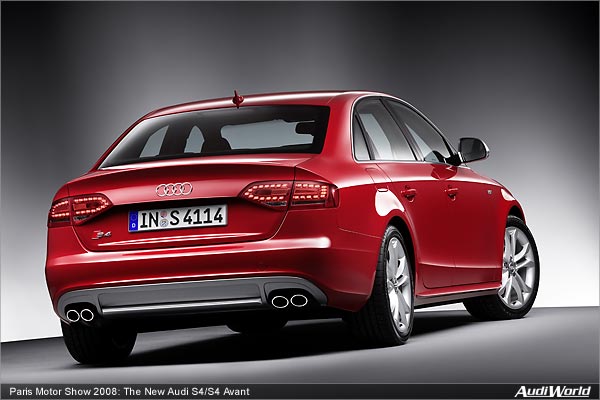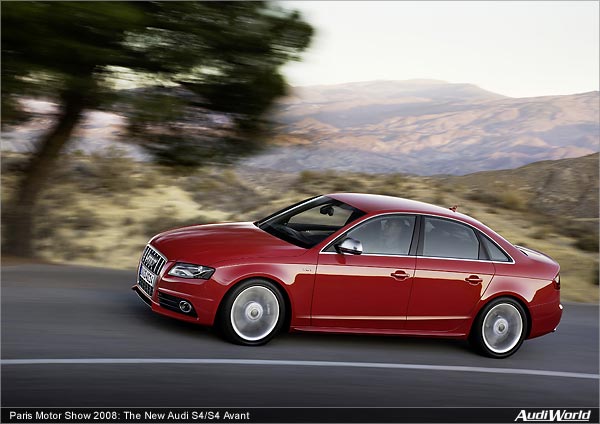The New Audi S4/S4 Avant

Ingolstadt – Audi is introducing its new sporty top models in the midsize class – the S4 and the S4 Avant. Their engine, a three-liter V6 with direct fuel injection and mechanical turbocharging, delivers a powerful 245 kW (333 hp). It accelerates the S4 to 100 km/h (62.14 mph) in just 5.1 seconds, but on average only uses 9.7 liters of fuel per 100 km (24.25 US mpg). The quattro permanent all-wheel drive system transfers its power to the road in style, which is then converted by the sport suspension into dynamic handling. Upon request, Audi can equip the new S4 and S4 Avant with innovative technologies that further increase their lead over the competition. The seven-speed S tronic changes gears with lightning speed, and the new sport differential distributes the torque as needed between the rear wheels. The new Audi S4 will be unveiled to the public for the first time at the Paris Auto Show from October 2 to 19.
The heart of the new S4 and S4 Avant is a completely redesigned engine. The 3.0 TFSI, the newest member of the Audi V-engine family, is an outstanding example of how the brand with the four rings blends performance and efficiency. The V6 generates its power from a displacement of 2,995 cc, is equipped with a supercharger, and delivers 245 kW (333 hp). The sedan sprints to100 km/h (62.14 mph) in just 5.1 seconds, and the Avant in 5.2 seconds: they both have an electronically governed top speed of 250 km/h (155.34 mph).
The “T” in the 3.0’s TFSI nomenclature no longer merely stands for “turbo”, but rather for the concept of supercharging in general extensive testing on the big V6 has proven the superiority of mechanical charging. In conjunction with direct injection it is far superior to twin turbochargers, both in terms of packaging and of starting performance and responsiveness.
The compressor is so compact that it easily fits inside the 90-degree V of the cylinder banks, in place of the intake manifold. Two four-vane rotary pistons counter-rotate inside the turbocharger at up to 23,000 rpm. Two charge-air coolers are integrated into the housing and are connected to a separate coolant circuit. An impressive array of measures keeps the noise generated by the compressor to a minimum.
The engine-driven belt that powers the mechanical charger provides full thrust right from idling speed. The 3.0 TFSI delivers its maximum 440 Nm (324.53 lb-ft) at 2,500 rpm and maintains this constantly until 4,850 rpm. In fourth gear, the vehicle accelerates from 80 to 120 km/h (49.71 to 74.56 mph) in just 4.4 seconds. Thanks to the extremely short gas paths, the sonorous, supercharged V6 responds spontaneously to the throttle, even more so than a naturally aspirated engine of the same displacement.
Furthermore, the new 3.0 TFSI achieves exemplary fuel efficiency. On average, the sedan uses 9.7 liters of fuel per 100 km (24.25 US mpg), and the Avant 9.9 liters per 100 km (23.76 US mpg) an improvement of 3.4 liters (26 percent) compared with its predecessor. The Audi technology of gasoline direct injection was what made this great efficiency possible in the first place. Unlike conventional concepts, it allows the compressor to be located behind the throttle valve. In view of the low density of the intake air at loads below supercharging level and when coasting, its rotors are free-running and the amount of power required to drive them is low.
Dynamism and efficiency: The new seven-speed S tronic
The V6 power in the new S4 and S4 Avant flows into a six-speed transmission, fitted as standard, which shifts quickly and precisely. As an option, Audi offers a state-of-the-art dual-clutch transmission the seven-speed S tronic is extremely dynamic and highly efficient. The driver has the option of driving in fully automatic mode or selecting the gears with paddles on the steering wheel or directly with the shift lever all of which provide impressively quick gearshifts. The gearshift feel is dynamic, comfortable and very precise typically Audi.
The seven-speed S tronic consists of two separate transmissions and uses two multidisk clutches that control the various gears. The large K1 clutch guides the power via a solid shaft to the pinions for gears 1, 3, 5 and 7. A hollow shaft rotates around the solid shaft; it is connected to the compact K2 clutch, which is integrated within its larger counterpart and controls the pinions for gears 2, 4, 6 and reverse gear.
Both transmission structures are continuously active, but only one is powered at a time by the engine. For example, when the driver accelerates in third gear, the fourth gear is already engaged in the second transmission structure. The shifting process takes place as the clutch changes K1 opens and K2 closes with lightning speed. This process takes only a few hundredths of a second and is completed without interrupting traction. It is so comfortable and smooth that the driver hardly notices it.
The seven-speed S tronic is designed for maximum efficiency. It operates with very high efficiency and its intelligent control system maximizes fuel economy in automatic mode. With its wide gear ratio spread of 8.0:1 the seven-speed S tronic easily exploits the tremendous power and superior torque of the 3.0 TFSI.
The quattro permanent all-wheel drive system transfers power to the road with supreme ease. Under regular driving conditions, it sends 40 percent of its torque to the front wheels and 60 percent to the rear wheels a slightly rear-biased, sporty characteristic. Where necessary, it can vary distribution within fractions of a second.
The quattro drive system ensures safe self-steering characteristics, high stability and excellent traction in comparison with rear-wheel-drive competitors.
Customized torque distribution: The sport differential with Audi drive select
The new, active sport differential ideally complements the quattro drive system and lends it even greater fascination. When the steering wheel is turned or the car accelerated in a corner, power is redirected in a controlled manner to the outer rear wheel, literally pushing the vehicle through the corner. The system intervenes to counter any signs of understeer or oversteer. For the driver, this means reduced effort at the steering wheel and even higher lateral acceleration.
The active sport differential is a new type of rear-axle differential. A superposition gear was added to both the left and right sides of the classic differential; it rotates ten percent faster than the wheel’s drive shaft.
Both components can be connected through a multidisk clutch, which runs in an oil bath, and is operated by an electro-hydraulic actuator. In most driving situations, the clutch can divert almost the complete input torque to one wheel in this way.
Controlled by an array of sensors and a high-speed computer, the active sport differential needs less than 100 milliseconds to redirect power. Drivers can adapt their manner of driving, along with characteristics for the load changes, to three performance maps. Unlike competitors’ systems, the Audi sport differential is just as effective when the engine is driving the wheels as it is on the overrun or when the car is coasting freely.
The new Audi S4 and S4 Avant are well-trained athletes. Their five-link front axle and the self-tracking trapezoidal-link rear axle are of a highly sophisticated design; both axles are made almost entirely of aluminum and are therefore very lightweight. The low-mounted steering gear transmits the steering forces to the wheels without any lag time and gives the driver a precise and sensitive road feel.
The spontaneity of Audi’s new midsize athletes is fascinating, and they possess the precise reactions of a thoroughbred sports car. In these transmissions, the differential is positioned in front of the clutch, which made it possible to move the engine 154 mm (6.06 in) forwards compared with the predecessor model. This unusual layout perfectly evens out the axle loads, and also affords the long wheelbase of 2,811 mm (9.22 ft) exceptional stability.
The chassis of both new S models received stiffer axle bearings, and the sporty tuning with stiff shock absorbers puts the chassis 20 mm (0.79 in) closer to the road. Huge high-performance and fade-resistant brakes sit behind the 18-inch and optional 19-inch cast aluminum wheels. The black-painted brake calipers at the front with the S4 logo grip the ventilated disks with newly developed brake pads.
Page: [1] [2]
|



